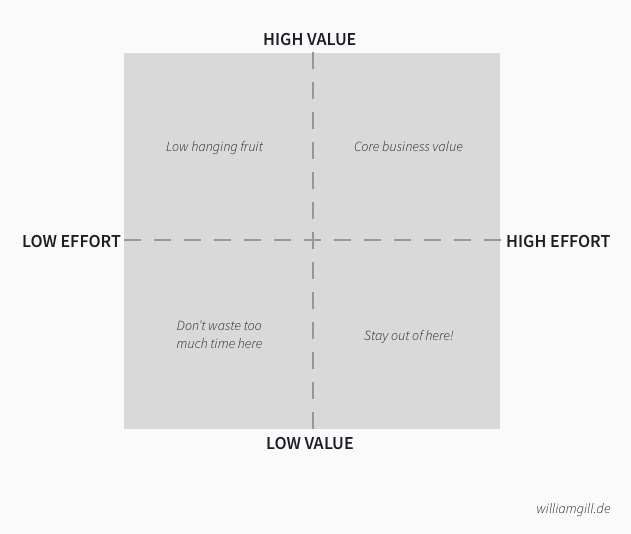I recently finished training a new Product Manager and on-boarding him onto a project. After his first week alone on the job full-time, he came to me on a Friday afternoon with a frazzled look on his face and asked me: “How do you cope with the continual and immense demands for my time as a PM – and then on top of that still find time to think about strategy
, talking to customers, and evangelisation?”
This is the science, and art, of prioritisation.
I could point him to a ton of resources about how to approach product backlog prioritisation, such as the ICE method. But what he really needed to hear is not how to prioritise a backlog (although this is also important). He wanted to know how to prioritise his time.
I came up with these principles:
- Ruthless prioritisation of everything. You have to sort the world into “things that are important and urgent right now” and “things that are not”. And then to make this work, you have to ignore the things in the “not important” column! This is where many people get tripped up: they prioritise well enough but then end up working on stuff from the ‘not important’ area because an executive wants it, or because an important customer is asking for it…
- But in order to prioritise, you need to have clear product goals. This sounds like “duh” but you’d be surprised how many product teams I’ve seen who have no idea what the goal for the quarter is. They have a roadmap, sure… but what is the measure of the success of that roadmap? What ONE result/metric are you trying to move in this period (month/quarter/year)? A test of a good goal is that a) everybody can remember it immediately, and b) you can use it to make individual prioritisation decisions at any level (feature level, roadmap level, strategy level, etc). If for any item on your backlog/roadmap, you can clearly say that it either contributes directly to that goal, or it does not: then it’s a good goal. If you cannot, it means that goal – or at least, that articulation of it – is not useful for prioritising your strategy, which means it’s not useful as a goal.
- Related: Stack rank everything. For any two items, you must always be able to say which is more important than the other. Try the experiment: pick any two items from your roadmap, backlog, or wherever. Then ask yourself: if you could only have one of these things, which would it be? Do you have an answer? Good! If you don’t, then you need to get better at stack ranking.
- And finally: get used to disappointing people. It’s natural for Product Managers to measure their success against how happy they make their customers – both internal customers (colleagues
, executives, engineers, designers, etc) and actual customers. But you’ll never be able to please everybody. We all agreed years ago that “design by committee” is a bad idea: try to build something for everyone, and you’ll end up building something for no-one. And yet, how many low-value items have you ever snuck into the roadmap because Sarah really wants it for her campaign, and she asked so nicely… Resist that urge. Learn to say (politely) no to requests, ideas and requirements that don’t align with what you’re trying to achieve right now. By all means, collect ideas often and from as many sources as you can: this can be a great source of inspiration and creativity for you. But don’t create expectations that every idea is created equal (because they aren’t).
This is how to stay productive – and stay sane – as a Product Manager.
Good luck!

